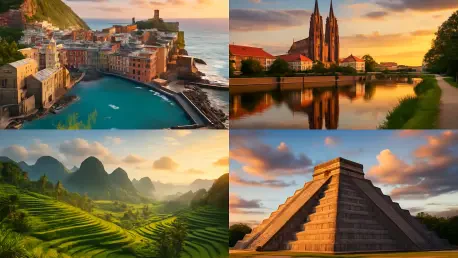In an era where iconic vacation spots like Paris, Bali, and Santorini have long dominated travel itineraries, a profound transformation is unfolding as 2026 approaches, with travelers increasingly turning their backs on overcrowded, overpriced destinations. They are seeking hidden treasures that offer genuine experiences, affordability, and a sense of discovery. This shift isn’t merely a passing fad but a reflection of deeper changes in priorities, driven by economic realities, cultural awareness, and a yearning for unique adventures. From ancient cities steeped in history to untouched wilderness and budget-friendly coastal escapes, the emerging hotspots of 2026 are redefining what it means to explore. This movement away from the predictable promises a fresh perspective on global tourism, inviting a closer look at the destinations capturing imaginations and the forces propelling them into the spotlight.
Rediscovering Cultural and Historical Depths
Travelers with a passion for history and culture are finding solace in destinations that offer a window into the past without the congestion of more famous locales. Uzbekistan stands out as a prime example for 2026, with its Silk Road cities like Samarkand and Bukhara presenting breathtaking architecture and ancient narratives of trade and tradition. Unlike the packed streets of European historical hubs, these places provide an intimate journey through time, where every mosaic and minaret tells a story. The appeal lies not just in the visual splendor but in the affordability and the chance to engage with a heritage that feels untouched by mass tourism. This growing interest highlights a desire for meaningful encounters over superficial checklists, positioning Uzbekistan as a cultural beacon for those eager to step off the beaten path and into a living history lesson.
Beyond the allure of ancient trade routes, the cultural shift also reflects a broader rejection of over-commercialized experiences in favor of authenticity. Destinations like Uzbekistan are gaining traction because they cater to a yearning for depth over display, offering travelers a chance to connect with local customs and histories in a way that feels personal. This trend is supported by a growing number of flight connections through major hubs, making such far-flung places more accessible than ever. Additionally, the lower cost of travel in these regions allows for extended stays, giving visitors the time to immerse themselves fully. As economic pressures push explorers toward value-driven choices, the cultural richness of these emerging spots becomes a compelling draw, promising not just a trip, but a transformative experience that lingers long after the journey ends.
Seeking Adventure in Untamed Landscapes
For those drawn to the call of the wild, 2026 is shaping up to be the year of untamed landscapes, with destinations like Kyrgyzstan leading the charge. Nestled in Central Asia, this rugged nation offers alpine lakes, towering mountains, and a nomadic culture that remains largely untouched by modern tourism. Unlike pricier adventure destinations such as Patagonia, Kyrgyzstan provides a budget-friendly alternative where community-based tourism ensures authentic interactions with locals. The raw beauty of its terrain appeals to hikers, trekkers, and nature enthusiasts who crave solitude over crowded trails. This rise in popularity underscores a shift toward experiences that feel exclusive and unscripted, where the journey itself becomes the reward, far removed from the polished predictability of mainstream adventure spots.
Equally captivating is the surge of interest in cold-climate adventures, with Anchorage and the broader Alaskan wilderness emerging as top picks. The allure of witnessing the northern lights, encountering wildlife, and navigating rugged terrains draws thrill-seekers who prioritize rare, unforgettable moments over tropical clichés. Alaska’s appeal lies in its vast, unspoiled expanses that offer a stark contrast to overdeveloped resort destinations, catering to a growing appetite for extreme-season travel. This trend is particularly pronounced among younger generations who value the uniqueness of such experiences over conventional getaways. As accessibility improves and interest in sustainable travel grows, these northern frontiers are poised to redefine adventure tourism, offering a glimpse into a world where nature reigns supreme and every trip feels like a pioneering expedition.
Embracing Affordable and Slow-Paced Escapes
For travelers seeking sun and serenity without breaking the bank, the Mediterranean charm of Albania and Montenegro is proving irresistible as 2026 nears. These Balkan countries offer stunning coastlines, historic villages, and a relaxed pace that rivals the allure of Italy or Greece, but at a fraction of the cost. The absence of mass tourism means quieter beaches and more authentic interactions with local life, making them ideal for families and couples looking for a stress-free retreat. Their rise is fueled by economic factors, as soaring prices in traditional hotspots push vacationers toward these “destination dupes” that deliver comparable beauty and culture without the hefty price tag. This shift highlights a growing preference for value-driven travel that doesn’t compromise on quality or charm.
On a different note, the concept of slow travel is finding a home in destinations like Nicaragua and Lake Atitlán in Guatemala, where affordability meets cultural immersion. These Central American gems cater to those who wish to linger, connecting deeply with local communities rather than rushing through tourist traps. Similarly, Southern Morocco offers a blend of desert and coastal landscapes, providing a warm winter escape rich in tradition and natural wonder, all at a reasonable cost. Unlike more commercialized regions, these areas prioritize genuine experiences over packaged vacations, appealing to creative spirits and budget-conscious explorers alike. This movement toward deliberate, meaningful travel reflects a broader desire to forge lasting memories through connection rather than consumption, reshaping how destinations are chosen and experienced.
Decoding the Forces Behind the Travel Shift
The pivot to these unconventional hotspots in 2026 is driven by a confluence of economic, cultural, and generational factors that are reshaping traveler priorities. Rising costs and overcrowding in traditional destinations have sparked a search for alternatives that offer similar vibes at lower expenses, often dubbed “destination dupes.” Environmental and cultural consciousness also plays a significant role, with many opting for sustainable travel that respects local ecosystems and traditions over fleeting, superficial visits. Younger generations, particularly Gen Z, are at the forefront of this change, pushing for unique, adventure-packed experiences that stand out on social platforms and personal narratives. This collective push against commercialization signals a profound evolution in how travel is perceived, favoring depth and individuality over mass appeal.
Navigating these emerging destinations, however, requires a bit more forethought compared to booking a trip to a well-known hub. Considerations such as flight connectivity, visa regulations, language differences, and varying levels of tourism infrastructure can pose challenges, yet the rewards often outweigh the hurdles. More space to explore, reduced costs, and authentic cultural connections make the extra planning worthwhile for many. Recent travel insights emphasize the importance of strategic booking to manage expenses, especially during peak seasons, ensuring that these lesser-known spots remain accessible to a diverse range of adventurers. As the landscape of global tourism continues to evolve, the focus on preparation and adaptability will likely shape how these unexpected hotspots are integrated into mainstream travel planning.
Charting the Path Forward for Global Exploration
Reflecting on the past, the journey toward unconventional travel in 2026 marked a turning point in how destinations were chosen and celebrated. The allure of hidden gems like Uzbekistan, Kyrgyzstan, and Albania had reshaped itineraries, prioritizing authenticity and affordability over familiar fame. Looking ahead, the challenge lies in sustaining this momentum by promoting responsible tourism that preserves the unique charm of these places. Travelers are encouraged to research thoroughly, engage with local communities, and consider off-peak visits to minimize impact while maximizing value. As the global tourism landscape continues to shift, embracing these emerging hotspots offers a chance to redefine exploration, ensuring that the spirit of discovery remains alive for future generations eager to uncover the world’s lesser-known wonders.









